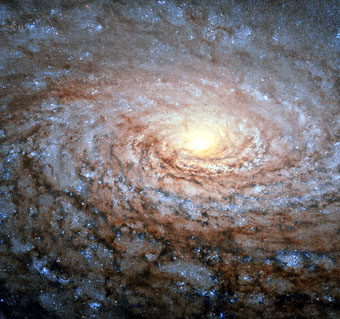
Spirals of the Sunflower Galaxy
| published October 26, 2015 |
By Keith H. Roberts, Thursday Review staff
The elaborate and colorful spiral arms of the galaxy known as Messier 63 come to life in this remarkable photo captured by the NASA/ESA Hubble Space Telescope in September. Cosmologists, scientists and astronomers have nicknamed the dazzling spiral formation the Sunflower Galaxy, for somewhat obvious reasons.
Messier 63 was first discovered by Pierre Mechain in 1779, and was added to the catalog of fellow Frenchman—and astronomer—Charles Messier in 1781, less than two years after its first observance. The Sunflower Galaxy is located in the northern constellation called Canes Venatici (The Hunting Dogs), a small but luminous area which both Mechain and Messier were studying closely when they came upon the Sunflower formation.
The Hubble image brings to life what those earliest observers saw: lots of more recently-formed blue-white mixed in among the pink and yellow stars; the blue stars giving the spiral arms their rich illumination and texture. Messier 63 is approximately 100,000 light years in diameter, which places it in the same size family as our own Milky Way.
The Sunflower Galaxy is also notable for recent history. In 1971 a magnitude 11.8 supernova appeared on one of the spiral arms. The supernova was observed by astronomers around the world.
Related Thursday Review articles:
A Very Sloppy, But Colorful Galaxy; Thursday Review staff; Thursday Review; August 15, 2015.
The Lonely Galaxy; Thursday Review staff; Thursday Review; June 16, 2015.
